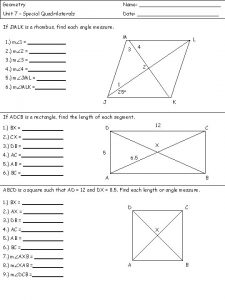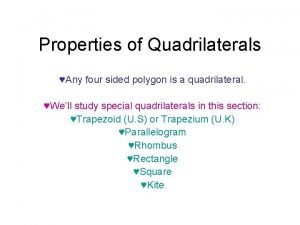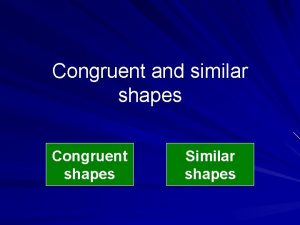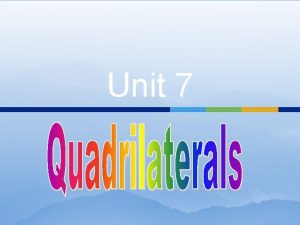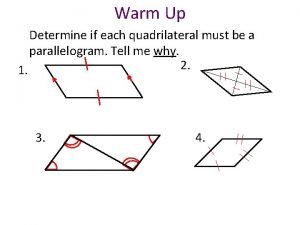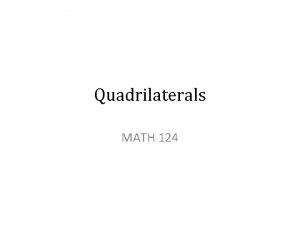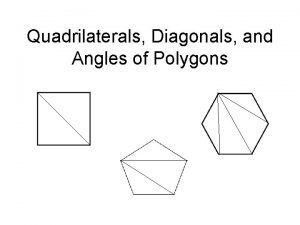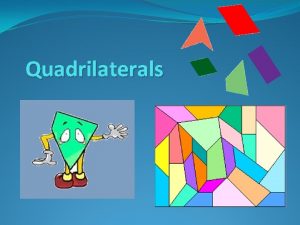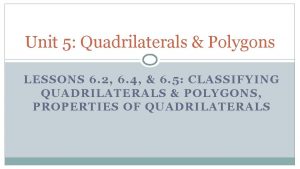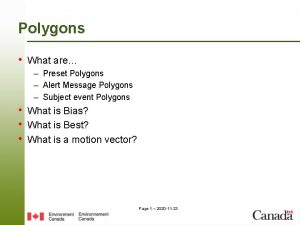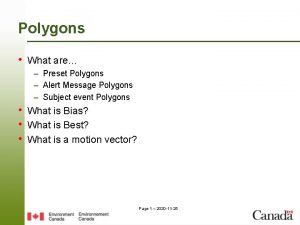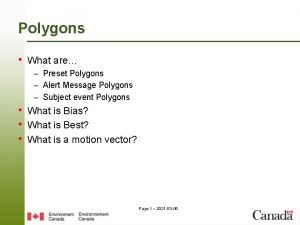Unit 5 Quadrilaterals Polygons LESSONS 15 19 32













- Slides: 13

Unit 5: Quadrilaterals & Polygons LESSONS 15, 19, 32, 52, & 69: CLASSIFYING QUADRILATERALS & POLYGONS, PROPERTIES OF QUADRILATERALS

Polygons Goals: To find the sum of the interior or exterior angles in a polygon. To identify the properties of various quadrilaterals. Essential Understandings: The sum of the interior angles of a polygon is equal to (n-2)180˚. The sum of the exterior angles of a polygon is always 360˚. Quadrilaterals have certain properties that help to identify the type of quadrilateral and can be used to solve problems involving quadrilaterals.

Polygons Goals: To find the sum of the interior or exterior angles in a polygon. To identify the properties of various quadrilaterals. Essential Understandings: The sum of the interior angles of a polygon is equal to (n-2)180˚. The sum of the exterior angles of a polygon is always 360˚. Quadrilaterals have certain properties that help to identify the type of quadrilateral and can be used to solve problems involving quadrilaterals.

Polygons Goals: To find the sum of the interior or exterior angles in a polygon. To identify the properties of various quadrilaterals. Essential Understandings: The sum of the interior angles of a polygon is equal to (n-2)180˚. The sum of the exterior angles of a polygon is always 360˚. Quadrilaterals have certain properties that help to identify the type of quadrilateral and can be used to solve problems involving quadrilaterals.

Polygons Goals: To find the sum of the interior or exterior angles in a polygon. To identify the properties of various quadrilaterals. Essential Understandings: The sum of the interior angles of a polygon is equal to (n-2)180˚. The sum of the exterior angles of a polygon is always 360˚. Quadrilaterals have certain properties that help to identify the type of quadrilateral and can be used to solve problems involving quadrilaterals.

Polygons Goals: To find the sum of the interior or exterior angles in a polygon. To identify the properties of various quadrilaterals. Essential Understandings: The sum of the interior angles of a polygon is equal to (n-2)180˚. The sum of the exterior angles of a polygon is always 360˚. Quadrilaterals have certain properties that help to identify the type of quadrilateral and can be used to solve problems involving quadrilaterals.

Polygons Goals: To find the sum of the interior or exterior angles in a polygon. To identify the properties of various quadrilaterals. Essential Understandings: The sum of the interior angles of a polygon is equal to (n-2)180˚. The sum of the exterior angles of a polygon is always 360˚. Quadrilaterals have certain properties that help to identify the type of quadrilateral and can be used to solve problems involving quadrilaterals.

Polygons Goals: To find the sum of the interior or exterior angles in a polygon. To identify the properties of various quadrilaterals. Essential Understandings: The sum of the interior angles of a polygon is equal to (n-2)180˚. The sum of the exterior angles of a polygon is always 360˚. Quadrilaterals have certain properties that help to identify the type of quadrilateral and can be used to solve problems involving quadrilaterals.

Polygons Goals: To find the sum of the interior or exterior angles in a polygon. To identify the properties of various quadrilaterals. Essential Understandings: The sum of the interior angles of a polygon is equal to (n-2)180˚. The sum of the exterior angles of a polygon is always 360˚. Quadrilaterals have certain properties that help to identify the type of quadrilateral and can be used to solve problems involving quadrilaterals.

Polygons Goals: To find the sum of the interior or exterior angles in a polygon. To identify the properties of various quadrilaterals. Essential Understandings: The sum of the interior angles of a polygon is equal to (n-2)180˚. The sum of the exterior angles of a polygon is always 360˚. Quadrilaterals have certain properties that help to identify the type of quadrilateral and can be used to solve problems involving quadrilaterals.

Polygons Goals: To find the sum of the interior or exterior angles in a polygon. To identify the properties of various quadrilaterals. Essential Understandings: The sum of the interior angles of a polygon is equal to (n-2)180˚. The sum of the exterior angles of a polygon is always 360˚. Quadrilaterals have certain properties that help to identify the type of quadrilateral and can be used to solve problems involving quadrilaterals.

Polygons Goals: To find the sum of the interior or exterior angles in a polygon. To identify the properties of various quadrilaterals. Essential Understandings: The sum of the interior angles of a polygon is equal to (n-2)180˚. The sum of the exterior angles of a polygon is always 360˚. Quadrilaterals have certain properties that help to identify the type of quadrilateral and can be used to solve problems involving quadrilaterals.

Polygons � Homework: Worksheet 6. 1 • Select Problems
 Special quadrilaterals
Special quadrilaterals Measure of one exterior angle of a pentagon
Measure of one exterior angle of a pentagon All quadrilaterals are polygons
All quadrilaterals are polygons Topic 6 quadrilaterals and other polygons answers
Topic 6 quadrilaterals and other polygons answers All polygons are quadrilaterals
All polygons are quadrilaterals Theorem 6-18
Theorem 6-18 Topic 6 quadrilaterals and other polygons answers
Topic 6 quadrilaterals and other polygons answers What makes shapes similar
What makes shapes similar Parallelogram congruent
Parallelogram congruent Quadrilaterals and coordinate proof unit test a
Quadrilaterals and coordinate proof unit test a Identify the following quadrilaterals
Identify the following quadrilaterals What is the name of a regular polygon of 3 sides
What is the name of a regular polygon of 3 sides Unit 10, unit 10 review tests, unit 10 general test
Unit 10, unit 10 review tests, unit 10 general test Determine whether the quadrilateral is a parallelogram.
Determine whether the quadrilateral is a parallelogram.
